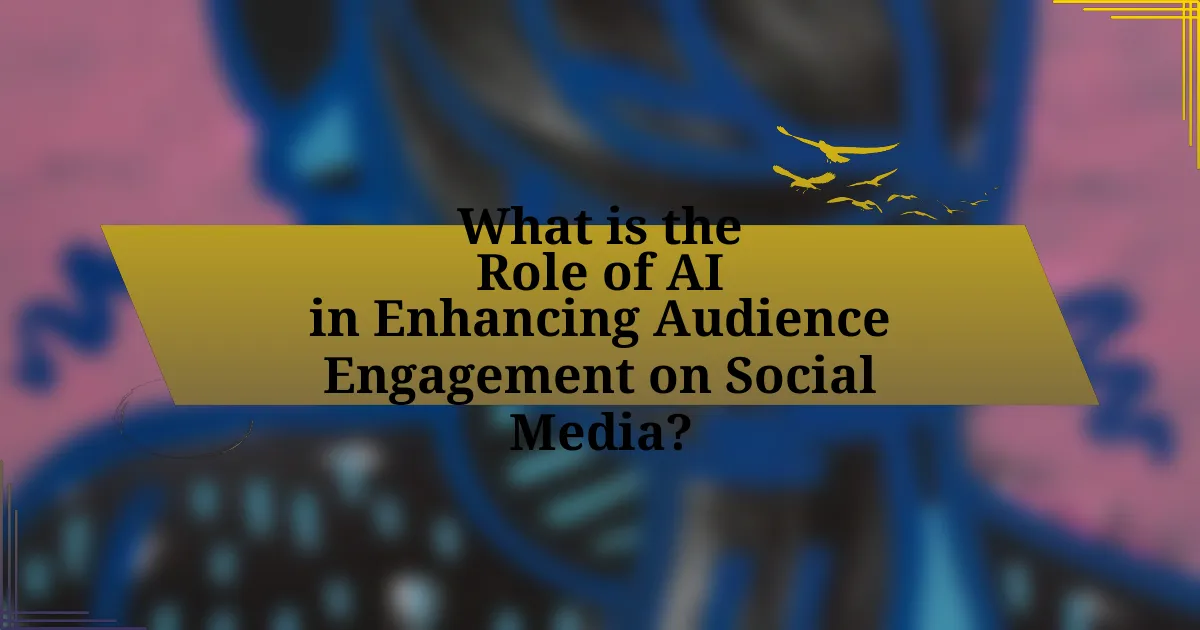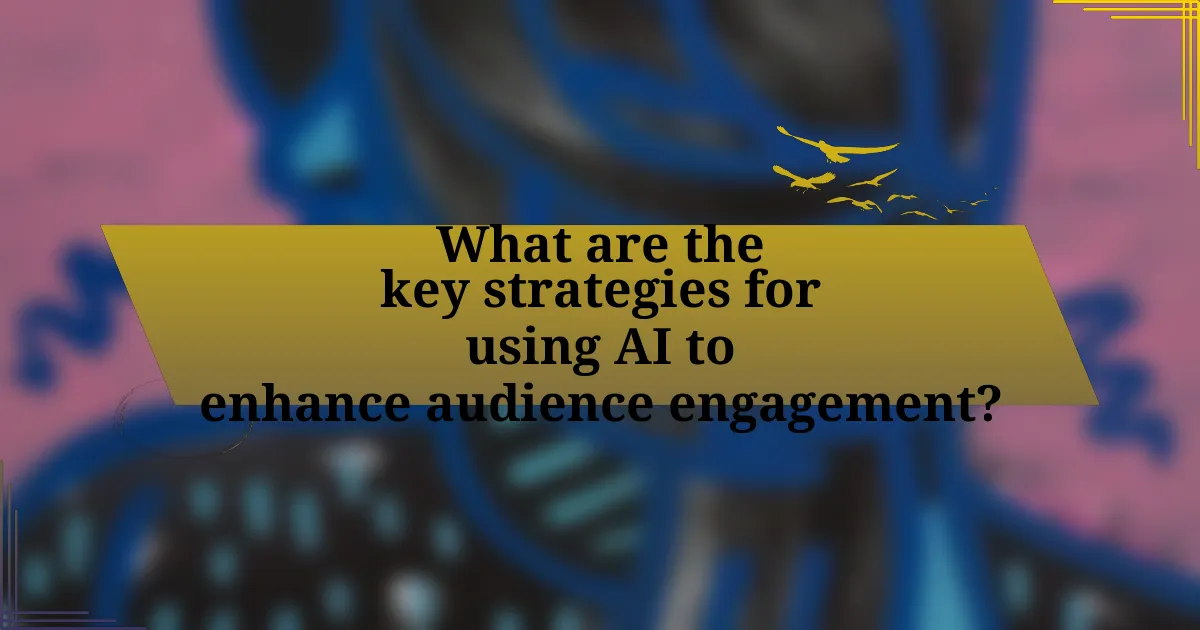The article focuses on the role of artificial intelligence (AI) in enhancing audience engagement on social media platforms. It outlines how AI analyzes user behavior and preferences to deliver personalized content, which can significantly increase interaction rates. Key AI technologies such as natural language processing, machine learning, and chatbots are discussed, highlighting their contributions to real-time communication and content optimization. The article also addresses the importance of audience engagement for brand visibility and loyalty, the metrics used to measure engagement, and the challenges and ethical considerations associated with implementing AI in this context. Additionally, it provides strategies for effective AI integration and emphasizes the need for personalization and data privacy in enhancing user experience.

What is the Role of AI in Enhancing Audience Engagement on Social Media?
AI plays a crucial role in enhancing audience engagement on social media by analyzing user behavior and preferences to deliver personalized content. This personalization increases interaction rates, as studies show that tailored content can boost engagement by up to 50%. Additionally, AI algorithms optimize posting times and formats based on audience activity patterns, further improving visibility and interaction. Tools like chatbots enhance real-time communication, providing immediate responses to user inquiries, which fosters a more engaging experience. Overall, AI’s ability to process vast amounts of data and adapt strategies accordingly significantly enhances audience engagement on social media platforms.
How does AI contribute to audience engagement on social media platforms?
AI enhances audience engagement on social media platforms by personalizing content and optimizing interactions. Through algorithms that analyze user behavior, AI can tailor posts, advertisements, and recommendations to individual preferences, increasing the likelihood of user interaction. For instance, a study by McKinsey & Company found that companies using AI for personalization can achieve a 10-20% increase in sales and engagement metrics. Additionally, AI-powered chatbots facilitate real-time communication, providing instant responses to user inquiries, which further boosts engagement levels.
What specific AI technologies are utilized for audience engagement?
Specific AI technologies utilized for audience engagement include natural language processing (NLP), machine learning algorithms, chatbots, and sentiment analysis tools. NLP enables the analysis of audience interactions and content, allowing brands to tailor their messaging effectively. Machine learning algorithms analyze user behavior to personalize content recommendations, enhancing user experience. Chatbots facilitate real-time communication, providing instant responses to audience inquiries, which increases engagement. Sentiment analysis tools assess audience reactions to content, helping brands understand audience preferences and adjust strategies accordingly. These technologies collectively enhance audience engagement by creating more personalized and responsive interactions.
How do these technologies improve user interaction?
AI technologies improve user interaction by personalizing content and enhancing responsiveness. These technologies analyze user behavior and preferences, allowing platforms to deliver tailored recommendations and relevant advertisements, which increases user engagement. For instance, a study by McKinsey found that companies using AI for personalization can see a 10-30% increase in customer engagement. Additionally, AI chatbots provide instant responses to user inquiries, improving the overall user experience by reducing wait times and increasing satisfaction.
Why is audience engagement important for social media success?
Audience engagement is crucial for social media success because it directly influences brand visibility, loyalty, and conversion rates. Engaged audiences are more likely to share content, which increases organic reach; for instance, posts with higher engagement receive 2.5 times more reach than those with lower interaction levels. Additionally, according to a study by HubSpot, brands that actively engage with their audience see a 20% increase in customer retention. This interaction fosters a sense of community and trust, leading to higher customer satisfaction and ultimately driving sales.
What metrics are used to measure audience engagement?
Metrics used to measure audience engagement include likes, shares, comments, click-through rates, and time spent on content. These metrics provide quantifiable data on how audiences interact with social media content. For instance, likes indicate approval, shares reflect content virality, comments show direct interaction, click-through rates measure interest in links, and time spent on content assesses engagement depth. Collectively, these metrics help in analyzing audience behavior and preferences, enabling more effective content strategies.
How does engagement impact brand visibility and loyalty?
Engagement significantly enhances brand visibility and loyalty by fostering direct interactions between brands and consumers. When consumers actively engage with a brand through likes, shares, comments, or direct messages, it increases the brand’s reach on social media platforms, leading to higher visibility. For instance, a study by Sprout Social found that brands with higher engagement rates experience a 20% increase in visibility compared to those with lower engagement. Additionally, consistent engagement builds trust and emotional connections, which are crucial for customer loyalty. According to a report by HubSpot, 70% of consumers are more likely to remain loyal to a brand that engages with them on social media. Thus, engagement not only amplifies visibility but also cultivates long-term loyalty among consumers.

What are the key strategies for using AI to enhance audience engagement?
Key strategies for using AI to enhance audience engagement include personalized content delivery, predictive analytics, and automated customer interactions. Personalized content delivery utilizes AI algorithms to analyze user behavior and preferences, allowing brands to tailor messages and recommendations, which has been shown to increase engagement rates significantly. Predictive analytics leverages historical data to forecast audience interests and trends, enabling proactive content creation that resonates with users. Automated customer interactions, through chatbots and virtual assistants, provide instant responses and support, improving user experience and fostering deeper connections. These strategies collectively enhance audience engagement by making interactions more relevant, timely, and efficient.
How can AI personalize content for different audience segments?
AI personalizes content for different audience segments by analyzing user data, preferences, and behaviors to tailor messages that resonate with specific groups. This process involves machine learning algorithms that segment audiences based on demographics, interests, and engagement patterns. For instance, a study by McKinsey & Company found that companies using AI for personalization can increase their marketing efficiency by 10 to 30 percent. By leveraging data analytics, AI can deliver targeted content, such as personalized recommendations or customized advertisements, enhancing user engagement and satisfaction.
What data is needed for effective content personalization?
Effective content personalization requires user data, including demographics, behavior patterns, preferences, and engagement history. Demographic data such as age, gender, and location helps tailor content to specific audience segments. Behavioral data, including browsing history and interaction frequency, informs content relevance and timing. Preferences, derived from user feedback and past interactions, guide the customization of content types and topics. Engagement history, which tracks user responses to previous content, enables the refinement of future content strategies. Collectively, this data enhances the ability to deliver personalized experiences that resonate with individual users, ultimately improving audience engagement on social media platforms.
How does personalization affect user experience?
Personalization significantly enhances user experience by tailoring content and interactions to individual preferences and behaviors. This customization leads to increased engagement, as users are more likely to interact with content that resonates with their interests. Research indicates that personalized experiences can boost user satisfaction by up to 80%, as users feel more valued and understood. Furthermore, platforms utilizing AI algorithms to analyze user data can deliver relevant recommendations, thereby improving the overall effectiveness of user interactions and fostering a deeper connection between users and the platform.
What role does AI play in analyzing audience behavior?
AI plays a crucial role in analyzing audience behavior by leveraging data analytics and machine learning algorithms to interpret user interactions and preferences. This technology enables marketers to identify patterns in audience engagement, such as peak activity times, content preferences, and demographic insights. For instance, a study by McKinsey & Company found that companies using AI for audience analysis can increase their marketing ROI by 15-20% through more targeted campaigns. By processing vast amounts of data quickly, AI provides actionable insights that help businesses tailor their strategies to enhance audience engagement effectively.
What tools are available for AI-driven audience analysis?
AI-driven audience analysis tools include platforms like Google Analytics, HubSpot, and Sprout Social. These tools utilize machine learning algorithms to analyze user behavior, demographics, and engagement metrics. For instance, Google Analytics provides insights into website traffic and user interactions, while HubSpot offers detailed reports on customer journeys and engagement patterns. Sprout Social focuses on social media analytics, helping brands understand audience sentiment and engagement trends. These tools are validated by their widespread use in digital marketing, with Google Analytics reporting over 30 million active users, demonstrating their effectiveness in audience analysis.
How can insights from audience analysis inform content strategy?
Insights from audience analysis can significantly inform content strategy by identifying audience preferences, behaviors, and demographics. Understanding these factors allows content creators to tailor their messaging, format, and distribution channels to better resonate with their target audience. For instance, data from a 2021 HubSpot report indicated that 70% of marketers who used audience insights saw improved engagement rates. By leveraging such insights, brands can create more relevant and personalized content, ultimately enhancing audience engagement and driving better results on social media platforms.

What challenges exist in implementing AI for audience engagement?
Implementing AI for audience engagement presents several challenges, including data privacy concerns, algorithmic bias, and the need for high-quality data. Data privacy concerns arise as organizations must navigate regulations like GDPR, which restrict how personal data can be used, potentially limiting AI’s effectiveness. Algorithmic bias can lead to skewed engagement metrics, as AI systems may inadvertently favor certain demographics over others, resulting in unequal audience representation. Additionally, the requirement for high-quality data is critical; without sufficient and accurate data, AI models may produce unreliable insights, undermining their intended purpose. These challenges highlight the complexities organizations face when integrating AI into their audience engagement strategies.
What ethical considerations should be taken into account?
Ethical considerations in the role of AI in enhancing audience engagement on social media include user privacy, data security, and algorithmic bias. User privacy is critical as AI systems often collect and analyze personal data to tailor content, which raises concerns about consent and data ownership. Data security is essential to protect sensitive information from breaches, as evidenced by incidents like the Cambridge Analytica scandal, where user data was misused. Algorithmic bias must also be addressed, as AI can perpetuate existing societal biases, leading to unfair treatment of certain groups. Studies have shown that biased algorithms can reinforce stereotypes, impacting user experience and trust in social media platforms.
How can brands ensure transparency in AI usage?
Brands can ensure transparency in AI usage by clearly communicating the purpose and functionality of their AI systems to consumers. This involves providing accessible information about how AI algorithms operate, what data they utilize, and the decision-making processes involved. For instance, a study by the European Commission in 2021 highlighted that 79% of consumers prefer brands that disclose their AI practices, indicating a strong demand for transparency. By adopting clear labeling, user-friendly explanations, and regular updates on AI developments, brands can build trust and foster a more informed relationship with their audience.
What are the potential biases in AI algorithms?
Potential biases in AI algorithms include data bias, algorithmic bias, and societal bias. Data bias occurs when the training data is unrepresentative or skewed, leading to models that reflect those inaccuracies; for instance, facial recognition systems have shown higher error rates for individuals with darker skin tones due to underrepresentation in training datasets. Algorithmic bias arises from the design choices made by developers, which can inadvertently favor certain outcomes over others; an example is predictive policing algorithms that disproportionately target minority communities based on historical crime data. Societal bias reflects existing prejudices in society that can be perpetuated by AI systems, such as biased hiring algorithms that favor candidates from certain demographics. These biases can significantly impact the effectiveness and fairness of AI applications in enhancing audience engagement on social media platforms.
How can brands overcome technical challenges in AI implementation?
Brands can overcome technical challenges in AI implementation by investing in robust infrastructure and skilled personnel. A strong technological foundation, including cloud computing and data management systems, enables efficient processing of large datasets essential for AI applications. Additionally, hiring or training data scientists and AI specialists ensures that brands have the expertise needed to navigate complex algorithms and machine learning models. Research indicates that companies with dedicated AI teams are 2.5 times more likely to achieve successful AI integration, highlighting the importance of human capital in overcoming technical barriers.
What resources are necessary for successful AI integration?
Successful AI integration requires a combination of skilled personnel, robust technology infrastructure, and quality data. Skilled personnel, including data scientists and AI specialists, are essential for developing and implementing AI solutions effectively. A robust technology infrastructure, such as cloud computing resources and advanced algorithms, supports the deployment and scalability of AI applications. Quality data is crucial, as AI systems rely on accurate and relevant datasets to learn and make informed decisions. According to a McKinsey report, organizations that prioritize these resources are more likely to achieve successful AI integration and enhance their operational efficiency.
How can brands measure the effectiveness of AI tools?
Brands can measure the effectiveness of AI tools by analyzing key performance indicators (KPIs) such as engagement rates, conversion rates, and customer satisfaction scores. These metrics provide quantifiable data that reflects how well AI tools enhance audience engagement on social media. For instance, a study by McKinsey found that companies using AI-driven analytics saw a 10-20% increase in customer engagement, demonstrating the tangible impact of AI tools. Additionally, brands can conduct A/B testing to compare the performance of AI-enhanced campaigns against traditional methods, further validating the effectiveness of their AI implementations.
What best practices should brands follow when using AI for audience engagement?
Brands should prioritize personalization, data privacy, and continuous learning when using AI for audience engagement. Personalization enhances user experience by tailoring content and recommendations based on individual preferences, which studies show can increase engagement rates by up to 50%. Data privacy is crucial, as 79% of consumers express concerns about how their data is used; brands must ensure transparency and compliance with regulations like GDPR. Continuous learning through AI algorithms allows brands to adapt strategies based on real-time feedback and analytics, improving engagement effectiveness over time.
How can brands maintain a human touch in AI-driven interactions?
Brands can maintain a human touch in AI-driven interactions by integrating empathetic language and personalized responses into their AI systems. This approach allows brands to create a more relatable and engaging experience for users. For instance, using natural language processing techniques, brands can analyze customer sentiment and tailor responses that reflect understanding and empathy, which has been shown to enhance customer satisfaction. Research indicates that 70% of consumers prefer brands that demonstrate empathy in their communications, highlighting the importance of a human-like interaction in fostering loyalty and engagement.
What are the common pitfalls to avoid in AI implementation?
Common pitfalls to avoid in AI implementation include insufficient data quality, lack of clear objectives, and inadequate stakeholder involvement. Insufficient data quality can lead to biased or inaccurate AI models, as demonstrated by studies showing that poor data can significantly degrade model performance. Lack of clear objectives results in misaligned efforts, making it difficult to measure success; research indicates that organizations with defined goals are 30% more likely to achieve desired outcomes. Inadequate stakeholder involvement can lead to resistance and lack of adoption, as evidenced by surveys revealing that projects with strong stakeholder engagement have a 70% higher chance of success.

